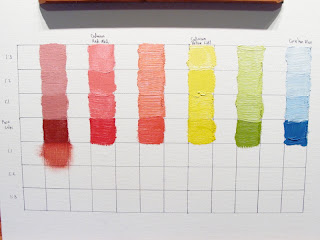I am back at the color wheel today, though this is not a wheel. I thought about calling it the color square except that it is a rectangle. Somehow color rectangle doesn't roll off the tongue very well so I call it the color matrix. I got the idea from doing the color wheel and seeing the color recipes in various color mixing books. It occurred to me after doing the color wheel that I am trying to paint and I don't even know what to expect when I start mixing colors. Sure, you can read books like the
Color Mixing Bible I mentioned in a prior post but there is nothing like doing it yourself.
So I decided to lay the color wheel out in a line and mix tints and shades to see how the colors react. In case you don't know, a shade is when you darken the color and a tint is when you lighten it. About the only way to lighten a color, as far as I know, is to add white. For shading, you can add black but I have read in multiple places that black paint mixed with other colors leads to dead looking colors. It seems the generally accepted way to darken a color is to add a little of its complement.
So now I had decided to do various levels of tints and shades so next up was to lay it out on a canvas board. I created a grid of 1" squares in a 7x12 matrix on an 11x14 canvas board. I used a T-square to be fairly precise with the layout. I put the pure color in the middle row of the 7 rows and that left room for 3 levels of tints in the top 3 rows and 3 levels of shades in the bottom 3 rows. So the end result will be the lightest shade on the top row and getting progressively darker down to the bottom row. I then had to decide which column to put the colors into. I decided to start on the left with the red hue of the color wheel and start to the right as I move clockwise around the color wheel so that the blue ends up in the far right column. I also started with the warm colors first with Cadmium Yellow Light, Cadmium Red Medium and Cerulean Blue as my primary colors.
Blank color matrix
Warm color palette
Now that I knew what I wanted to do, I had to figure out how to do it. I grabbed a piece of palette paper and squeezed out a little of each of the 3 primary colors in a 4x3 grid on the paper. I then added a little white next to the appropriate piles of color, starting with a little white on the 2nd row from the bottom and increasing the amount of white as I moved up rows. The bottom row was the pure color. The way I laid out the palette matched the way it was going to go onto the canvas board. I went with a ratio of 1:1 for the pure color and white to start. Then I went to a ratio of 1:2 where I had twice the white paint as the pure color. The final ratio was 1:3. If I ever do this again, I might use the following ratios, 2:1, 1:1, 1:2 as the colors lightened up quickly and the resulting colors were only slightly lighter than the next.
Palette before mixing
Palette after mixing
Now it was time to put the brush to canvas. I started with the pure colors and worked my way up to match the matrix I had laid out. I wiped the brush as clean as possible before doing each color swatch to avoid contaminating the patches of color. The result showed subtle differences between each tint. That shows how many variations you can create by just slowly adding more and more white. As I mentioned above, I wish I had not started with such a strong mix for the first swatch to maybe see a little more variation. A note about the red column is that it turns pink in a hurry when you start adding white. The yellow and blue made beautiful tints.
The primary colors
Now that the primary colors are complete, next up was the secondary colors. This time the mixing was a little more involved. I added the primary colors evenly (1:1) and then added the white. I had to use more white this time since I had twice the amount of color in each swatch.
I was anxious to see the tints of the secondary colors and they did not disappoint. The secondary colors were beautiful, well except for the reds. Not that the reds were ugly, but the greens and oranges were spectacular.
Ready to mix the secondary colors
The secondary colors
The primary and secondary colors
The next phase of this exercise is to create the tints for the tertiary colors. I am anxious to see those as well. Once the tints are done it will be time to do the shades. I am not sure how those will turn out so I am looking forward to that exercise. As I mentioned earlier, shades should be made by adding the complementary color so there will be a lot of mixing involved in creating the shades as I will have to vary the amount of the complementary color to add.
The final part of this exercise is to do the same matrix for the cool colors. I am sure this will be quite a tedious chore by then but it should be well worth it. After all, how can you sit down and paint when you don't even know how the color will react to the mixes?


















